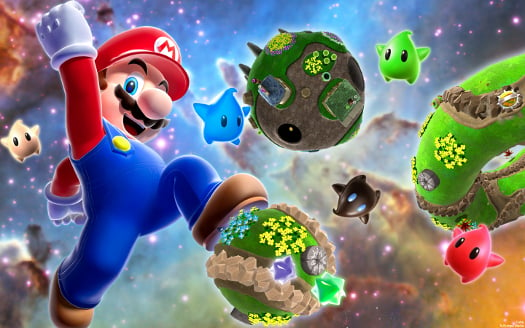
This year, Nintendo’s Mario series of video games celebrates its 25th birthday, as well as the retention of worldwide popularity. The brainchild of Japanese designer Shigeru Miyamoto, Mario occupies a position in popular culture usually reserved for iconic pop stars and long-running TV series. And with 222 million games sold over the last quarter-decade, its commercial success certainly can’t be disputed.
So why is Mario so popular? His distinctive red cap, blue overalls and moustache may have been born out of the technical limitations of 80s games consoles (his Italian nationality comes from the fact that he has a moustache - no, seriously) but as a blank avatar for the player to project themselves onto, he is peerless.
Mario's USP has always been exploring the joy of movement, allowing players to navigate intricately-designed spatial challenges with a character who feels like an extension of your own body. Mario’s original name was simply "Jumpman", and for good reason - in later games, his cries of "yahoo!" with every leap are positively infectious. Not to mention Mario's colourful supporting cast - Luigi, Bowser, dinosaur-thing Yoshi - who despite their paper-thin characterisation have become as iconic as the star himself.
Most, however, know Mario et al best from the most popular of the (seemingly endless) spin-offs: Mario Kart, which has provided both hours of knockabout fun and an antithesis to boring driving simulators like Gran Turismo. You'd be hard pressed to find anyone that doesn't flinch at the sight of that dreaded blue shell.
The craftsmanship of the Mario games has meant they have stood the test of time, and are still receiving lavish critical praise and selling by the bucket-load. Stuffed full of imagination, tightly-designed levels and endless surprises, it’s difficult to overestimate the influence they have had on video games as an art-form.
The 1985 classic Super Mario Bros. was the beginning of shift from arcades into living rooms, with large and colourful graphics that - though difficult to believe now - looked like a cartoon come to life, spawning a variety of imitators (most notably Sega's Sonic the Hedgehog). In 1997, Super Mario 64 demonstrated what games could do with a third dimension, which in turn influenced another generation of 3D Mario rip-offs such as Crash Bandicoot and Spyro the Dragon.
The imitators will long be forgotten - but Mario games continue to thrill both children and adults alike.
Originally published in The Courier on the 8th November 2010.

No comments:
Post a Comment